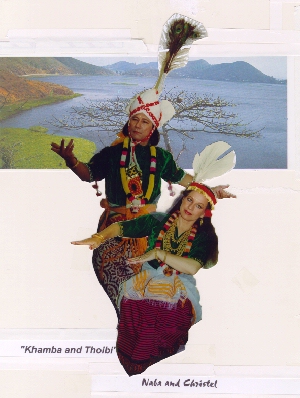|

|
| Laiharaoba, by Nabaghana Shyam and Christel Stevens |
Manipur is a land of melodies and rhythms. Long before it's classical dance styles evolved, it had folk forms of music
and dance, viz. Khulang Ishei and Lai Haroaba. A prime community festival of Manipur held during the months of April and May,
Lai Haraoba re-enacts the creation of the Universe. All the processes of creation as per the Meitei cosmogony are symbolically
depicted through rituals, prayers, dances and songs of Lai Haraoba. The Meiteis believe that doing this would please the supreme
deity Taibanpanba Mapu and all beings on earth would be blessed with happiness and prosperity. From the 17th century,
the Manipuris came under the influence of Vaishnavism, the devotional cult of Hinduism. The Vaishnavite music and texts combined
with the local flavour to evolve a subtle and stylised dance form that's uniquely Manipuri in nature.

|
| Poushali as Krishna in Rasleela |
Bhakti or devotion is the essence of this dance style - Manipuri dance is the only dance that is still performed in the
temple. In fact it is still essentially a way of worshipping god than an art form on its own. That may explain why the rich
heritage of this dance style, which existed from the primeval age but flowered into a classical style recently, is not widely
known. It is at once the oldest and youngest of classical Indian dances, and combines total self dedication with technical
skills in its unique form.
Special thanks to Christel Stevens, a well known Manipuri Dancer in the USA, for giving permission
to use her photograph on this site.
  
|
 |
 
Artistes of Manipuri Dance
The Original Gurus: Guru Amudon Sharma, Guru
Amubi Singh, Guru Atomba Singh
The Masters: Guru Bipin Singh, Ojha Babu Singh, Khetritombi Devi,
Gambhini Devi, Thoranisabi Devi, Guru Nadia Singh, Guru Amuiyaima Singh
The Senior Artistes: Nayana Jhaveri, Ranjana Jhaveri, Darshana
Jhaveri, Suverna Jhaveri, Kalavati Devi, Binodini Devi, Shantibala Devi, Singhajeet Singh, Devjani Chaliha, K.Jatindra Singh,
Ojha Ranjeet Adhikari, Nabaghana Shyam
The Young Exponents: Priti Patel, Sruti Banerjee, Latasana
Devi, Poushali Chatterjee, Indrani Devi, Bimbavati Devi, Sanjib Bhattacharya, Lakshmi Devi
Thang-Ta Exponents: Ojha Devavrata, Ojha Gourkishore Sharma, Ranjeet
Chingtham
|
 |
|
|
|




